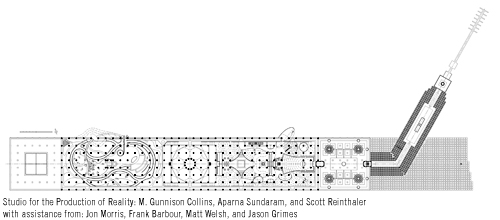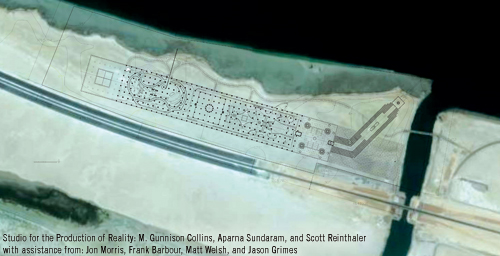Studio for the Production of Reality:
M. Gunnison Collins (Lead Designer & Producer)
Aparna Sundaram (Clean Tech Analyst)
Scott Reinthaler (Architectural Illustrator)
With assistance from:
Jon Morris, Interactive Performance Artist, The Windmill Factory
Frank Barbour, Landscape Architect, The Windmill Factory
Matt Welsh, Graphic Designer, KillDiscoDesign
Jason Grimes, Illustrator
Designed for Site #2 in Abu Dhabi, between Saadiyat Island and Yas Island.

Design Submission for the 2010 Land Art Generator Initiative Design Competition
Artist’s descriptive text:
AP-REP challenges our psycho-social assumptions regarding the creeping ubiquity of the “Big Box,” as a symbol of dehumanized contemporary life, by subverting that form’s use for direct civic good and public enrichment. Such an industrial scale structure may at first appear as overwhelming as Big Industry, itself. But it is only within that context that any potentially successful movement toward sustainable human existence must be made. Sustainability is not anathema to the future of a successful U.A.E., as some in the west might postulate. Rather, any vision that ignores its continued success is not a sustainable vision at all. AP-REP proposes a narrative by which this premise might not only appear realistic, but appealing and desirable.
In the wake of the 20th Century, it is clear to us that any attempt to reconcile the seemingly disparate constructs of nature and artifice through the use of visual analogy or conceptual art is desperate, futile, and a legitimate expression of trauma, at best. The struggle to find harmony between the two by approaching them through the decorative arts offers some relief. When mankind proceeds under the illusion that humanity and nature are somehow fundamentally at odds, rather than seeing them as microcosmic echoes of each other, we unwittingly maintain a general denial of human nature.

It is human to seek shelter in familiar things – all familiar things being essentially man-made, even Nature, itself. It is human to fend off destitution and loneliness with fanciful hopes of redemption and the comfort of intimate sentiments shared under shelter. In more temperate climes, nature is something we approach as the Other for comfort. Any vision that claims we can live symbiotically in peace with nature has a utopian flair that offends common sense or may seem ridiculously idealistic, when viewed from within the conventional polar dichotomy. There is no imperative reason to see things in such a fractured way. For through acculturation and time all forms lose the teeth of their original intent and gain an organic trajectory within passing society. All things return to nature.
Despite the feelings of personal detachment and the individual’s sense of alienation that often accompany contemporary corporatized social forms (embodied by the Big Box structure), we can take some personal, if morbid, comfort in the knowledge that humanity’s legacy will be biological. All of the institutions which fence us in will deteriorate in the sands of time, leaving only ruins, remnants, and habits. Of this we can be certain. For this reason, man-made things ought look man-made without concern, for by that quality they glorify humanity and nature.

And so in response, AP-REP’s seemingly violent imposition on the landscape is designed to accommodate both graceful deterioration and conservation by way of re-use and adaptability. It is a place that, from Abu Dhabi, appears monolithic and brutal, not unlike the desert itself, yet upon approach becomes transparent and alive. The super-structure is a dynamic shade regulating device that enables a multiplicity of social institutions as a civic oasis. At its functional core, here is an armature for the scientific exploration of solar technologies. The peripheral functions are manifold and complimentary to that end.
The Park’s expression recalls an earlier era in the Islamic world when royal benefactors endowed public monumental destinations for the enrichment of their citizenry, such as the Great Mosques, Hamam, Caravansaries, Hospitals, Madrassas, Türbe & Mausoleums, “Lunatic Asylums,” (literally refuges for the mentally impaired), Parks & Avenues, Bazaars and Imperial Colonies. It harkens back, in its tectonic imagery to the world’s first era of Industrialization, when new technologies found expression in the monuments of the day, such as the Eiffel Tower, London’s Crystal Palace, Paris’s Biblioteque Nationale, and New York’s old Penn Station. The complexity of program is in keeping with recent aesthetic developments in Islamic Culture, making concession to entertainment and leisure complexes throughout the region. Through establishing itself in the alternative energy industry and by voluntarily giving renewable resources a vibrant role within the local social fabric, the U.A.E. can ensure the longevity of its ascent in a more sustainable world. That is the modest aspiration of this proposal.

The super-structure is divided into five 160mx160m square sections. Each section is an open platform for a different type of solar energy collection device, each able to be retrofitted with new technologies as they emerge. A retractable crane on a rail track, located along the south side of the structure, provides the means for these transitions. Towers enabling the capture of the sun’s energy rise out of the structure, reminding us of power plants and lighthouses. The heliotropic motion of all but one of the solar-collection systems gives expression to the sun’s movement and offer dynamic shade as protection from the elements. Foil faced roman-shades at the perimeter are held in position by taught catenaries and are raised or lowered for maximum comfort and to regulate solar exposure in the area beneath the permeable solar-collecting roof. They billow and ripple in the wind as a soft façade.

The AP-REP super-structure has been designed to be a platform for five existing solar technologies, all of which are commercially available and in use today, but are not yet cost-competitive. Innovation is still required mainstream these commercial technologies. Re-positioning these and other technologies, such that they become ubiquitous and inarguably modern features in the landscape is AP-REP’s goal. This is a vision of a near future: modernity that aspires to harmony between nature and human nature is its core thesis. The initial cost of this facility is estimated to be between US$1b and US$2b.
The sun’s energy is captured on the rooftop of the great hall through photovoltaic, concentrated photovoltaic, solar thermal and solar convection technologies. Photovoltaic energy is used in two sections, employing different technologies: tandem junction amorphous silicon (a-Si) and copper indium gallium selenide (CIGS), both of which attempt to solve the issue of cost in different ways. A-Si can be produced in extremely large panels, highlighting that its solution to the cost problem is scale. CIGS can be produced in flexible strips of extremely small sizes, highlighting that its solution is volume. Both technologies can be used in building-integrated photovoltaic [BIPV] products, emphasizing that their goal is not simply energy generation, but also efficiency. BIPV enables distributed generation, giving people the benefit of powering their homes, vehicles, equipment, and appliances independently. Both a-Si and CIGS have the potential to displace a portion of revenues in the construction industry that go towards inefficient or single-use materials. Capture of just 0.05% of the world construction market will reap benefits of close to $2 billion dollars a year.

Concentrated photovoltaic (CPV) and concentrated solar thermal are used in two other separate sections. These technologies seek to solve energy and cost problems through massive scale and centralized designs. They are appropriate where cheap land is available and solar resources are abundant – such as desert lands. CPV uses mirrors to reflect radiant energy from the sun, concentrating it onto a single photovoltaic collector. The collector converts the solar energy to electricity in the same way as a-Si and CIGS – by passing the radiant energy through a semiconductor material which draws out electrons and creates the current that is electricity. Solar thermal reflects radiant energy from the sun to a collector which contains water. Water temporarily stores heat energy, which can be used directly or converted into power to be stored long term. Both of these technologies have the potential to displace large-scale fossil fuel facilities. Just a 0.05% redirection of global energy revenues will earn over $1 billion dollars in a year.
The last technology used on the AP-REP roof is a solar chimney. This is the lowest cost solar technology, but also the least efficient. Radiant energy from the sun heats air below the glass roof of a low, flat enclosure. As the heated air rises, the stack in the center of the structure channels the air upwards. A turbine within the tower uses the resulting updraft to create electricity. Simply put, convection created by confined radiant energy generates power.
These five technologies highlight the possibilities for harnessing solar energy: electricity, heat, and convection are but a few. The Innovation Center housed within the labs in the low, western-most bay invites scientists and product developers to collaborate on refining existing methods and creating new ones in order to solve critical issues of the 21st century in a practical and sustainable way. The hall itself and the structure above provide the opportunity for these innovations to be showcased to the citizens of and the visitors to the U.A.E. A solar technology innovation that captures just 4% global solar market share would earn $1.4 billion a year.
[…] innovation that captures just 4% global solar market share would earn $1.4 billion a year. Source: Land Art Generator Initiative Reageer […]